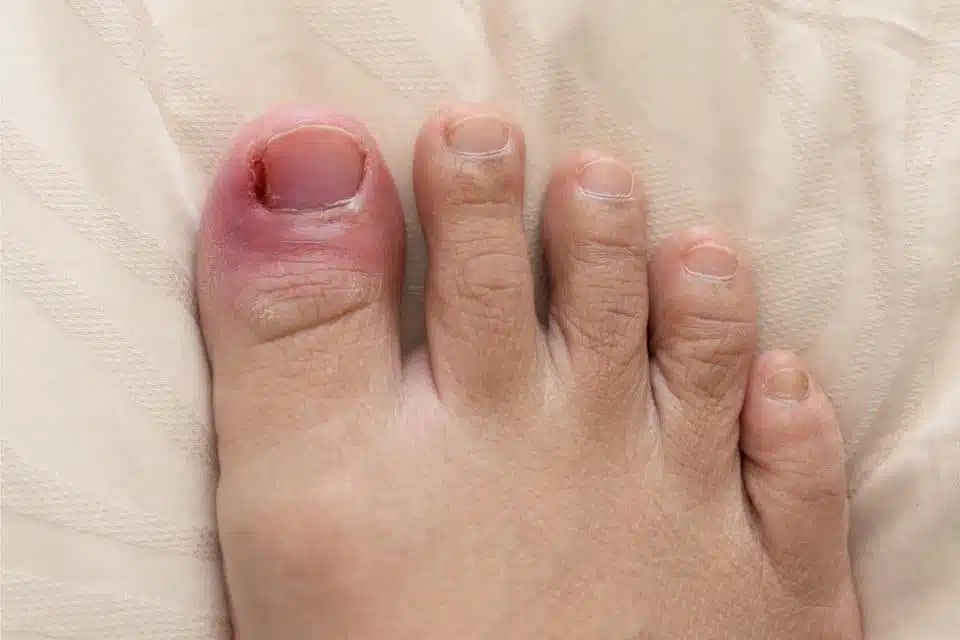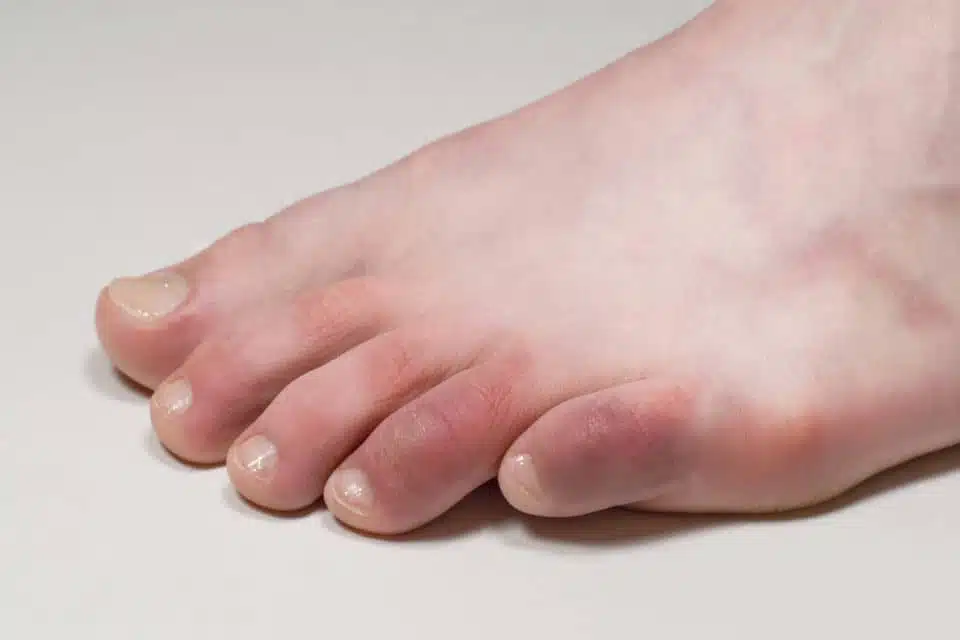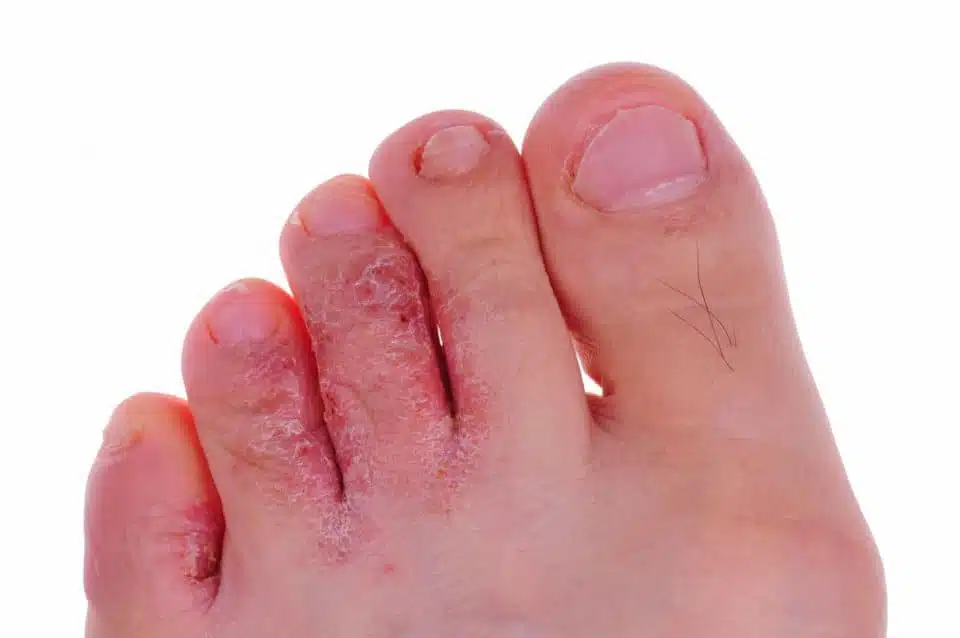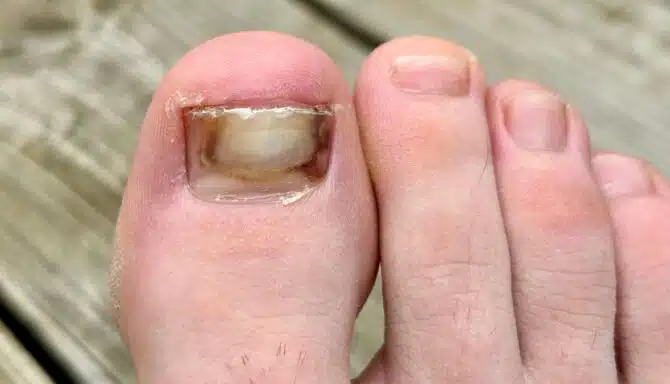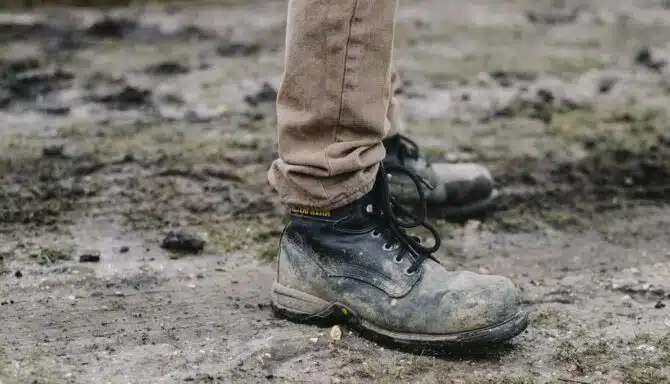Under normal conditions, the colour of your toes will match your natural skin tone. However, with foot conditions that cause red toes, a slight reddish discolouration appears. This discolouration may be more or less noticeable depending on your normal skin colour and the severity of the underlying condition.
There are a number of reasons why your toes may be red or show signs of slight discoloration. From skin conditions to foot conditions to reactions to temperature, we break down the variety of red toe causes below.
In this article, we will provide an overview of red toes, explain its possible causes, and help you make informed decisions about treatment and prevention for each related foot, nail, or skin condition.
Red toes: Possible causes
The appearance of redness in your toes often comes from one of the following:
- Inflammation;
- Injury, Pressure and Friction;
- Temperature (typically cold); or
- Infection.
Most of the above cause increased blood flow, which in turn can make the toes turn a reddish colour. Keep reading to learn more.
Inflammation
Inflammation occurs when your body fights infections, injuries, and other toxins in an effort to protect itself. This process increases blood flow to the affected area. By encouraging greater blood flow, more cells can reach injured tissue, which allows your body to heal and repair tissue and muscles. The increased blood flow to the area can make the skin appear reddish. Inflammation can also make the area hot.
The following are examples of inflammatory conditions that can make your toes turn red:
- Arthritis: There are over 100 different kinds of arthritis, but almost all them have one thing in common – joint inflammation. If you have arthritis in your toes, the inflammation buildup can make the skin over the inflamed joint turn reddish and swell. Examples of arthritis conditions that cause red toes include: gout, rheumatoid arthritis and psoriatic arthritis. Note: Osteoarthritis is the exception to the rule, in that it involves relatively little inflammation.
- Bunions: A bunion (also known as “hallux valgus”) is a deformity where the joint that connects the big toe to the foot (the “first metatarsophalangeal joint” – or “MTP” joint) becomes misaligned, protrudes outward and bends towards the second toe. The joint often becomes stiff, inflamed, and painful. The inflammation causes the toe to turn red. If your shoes also don’t accommodate the bunion, the friction from your big toe joint rubbing against your shoes can also make it red.
- Contact dermatitis: Contact dermatitis is a red, itchy rash caused by an allergic reaction. The allergic reaction causes skin inflammation, which forms a rash. The rash isn’t contagious or life-threatening, but it can be very uncomfortable. Many everyday items can cause contact dermatitis, like soaps, plants, detergents and jewelry. The best way to treat (and prevent) contact dermatitis is to identify and avoid the allergen. Your family doctor or dermatologist can also prescribe medications and creams to help treat any flare-ups.
- COVID toe: A red itchy rash on the toes can be a rare side effect of COVID-19 infection. Not much is known about this syndrome; however, it is believed to be related to the body’s immune response when fighting the virus.
Injury, Pressure and Friction
Acute injuries to our toes can also make our toes appear reddish. This is mostly caused by our body’s inflammatory response by which it heals itself. As explained above, when we injure ourselves, our body directs blood to the affected area. The blood contains the nutrients needed to heal the injured area. Examples of injuries that can make your toes red are:
- Toe fractures
- Ingrown Toenails
- Friction: Repeated friction (i.e.: from your toes rubbing against ill-fitting shoes) can cause redness, as well as other issues like blisters and calluses.
- Pressure from impact (playing soccer much?)
Temperature
It can get quite cold in Canada – eh? To keep us warm on those crisp winter days, our blood vessels constrict (or narrow), which reduces blood circulation and minimizes heat loss. Conversely, heat (and inflammation) widens or expands our blood vessels, which increases our circulation. However, when we get too cold, the skin and vessels can get damaged, which can trigger another reaction that can make your toes turn a reddish colour.
Typically, exposed skin is the most prone, especially in cold, windy conditions. Even though our feet are not often exposed directly to the elements (unlike hands, nose, and ears), the thin layer of skin and tiny blood vessels in our feet makes them vulnerable to cold.
For that reason, red toes from the cold are often caused by inadequate footwear, socks, or prolonged exposure outside. To make sure your feet are adequately protected when you go outside:
- Wear footwear that is well-insulated and waterproof
- Wear warm socks
- Avoid tight fitting footwear (tight shoes reduce blood flow to your feet, which makes them even colder).
- Avoid staying outside for prolonged periods of time
The following temperature related conditions can cause red toes:
- Chilblains: Also known as pernio, chilblains are the most common cause of temperature-related toe redness. It can cause itching, red patches, swelling, and blistering on your hands and feet. Chilblains are painful inflammations of small blood vessels in your skin that occur in response to repeated exposure to cold air. Per myfootdoctor.com, “it is the rapid widening of the blood vessels in the toes and the sudden rush of blood (and the increased pressure) when the feet are suddenly exposed to the warm temperatures that causes the damage to the blood vessel walls. This results in blood leaking out into the surrounding tissues and causing the redness, swelling and discomfort.” To avoid chilblains, it’s recommended to warm up gradually at warm temperature for at least 20 minutes; do not put your toes immediately in hot water. It’s also important to return indoors when you start to feel your feet getting too cold; otherwise, your chilblains can turn to frostbite.
- Frostbite: Frostbite is an injury caused by the freezing of the skin and underlying tissues. It’s characterized by cold and red skin that ranges from numbness to hard and pale. This skin condition is most common on the fingers, toes, nose, ears, cheeks, and chin.
- Raynaud’s disease: Raynaud’s disease is a condition of toe discolouration after exposure to hot and cold temperatures. Your toes may turn white, then blue in response to cold temperatures. Conversely, your feet and toes may turn red in response to warmth since the small blood vessels overcompensate for the temperature change.
Infection
We’ve talked a lot about how our body tries to heal itself when injured. However, sometimes, it isn’t successful. When that happens, we can get an infection. Just as the inflammatory response designed to prevent infection can cause redness, so too can infection itself. The following are infections that can make your toes red:
Nail infections
Known as paronychia, an infection of your nail folds is typically caused by bacteria or a fungus and can cause toe pain and swelling, which causes redness and the appearance of red toes.
Skin infections
As the largest organ in the body, our skin is our outermost protection against foreign germs and bacteria. When our skin becomes irritated or infected, it swells, causing redness. There are four main types of skin infections:
- Bacterial skin infections: Bacterial skin infections often begin small, as red bumps, and may slowly grow in size. Some bacterial infections are mild and easily treated with topical antibiotics. Others may require an oral antibiotic. Examples include cellulitis, impetigo, and boils.
- Viral skin infections: Viral skin infections are caused by a virus. These infections range in severity from mild to serious. An example of a viral skin infection that affects the feet is warts.
- Fungal skin infections: One of the most common culprits behind red toes, fungal skin infections are caused by a fungus. They’re likely to develop in damp areas of the body, such as the feet, although it can happen anywhere on the body. Examples include athlete’s foot, and nail fungus. Athlete’s foot in particular is a very common cause of toe redness. Athlete’s foot is by no means a life-threatening issue; however, it is contagious and can spread to other parts of your body or to other people. It can also cause foot pain and difficulty walking if left untreated. Fungal infections can be very difficult to treat on your own. Fortunately, there are many ways a chiropodist can help.
